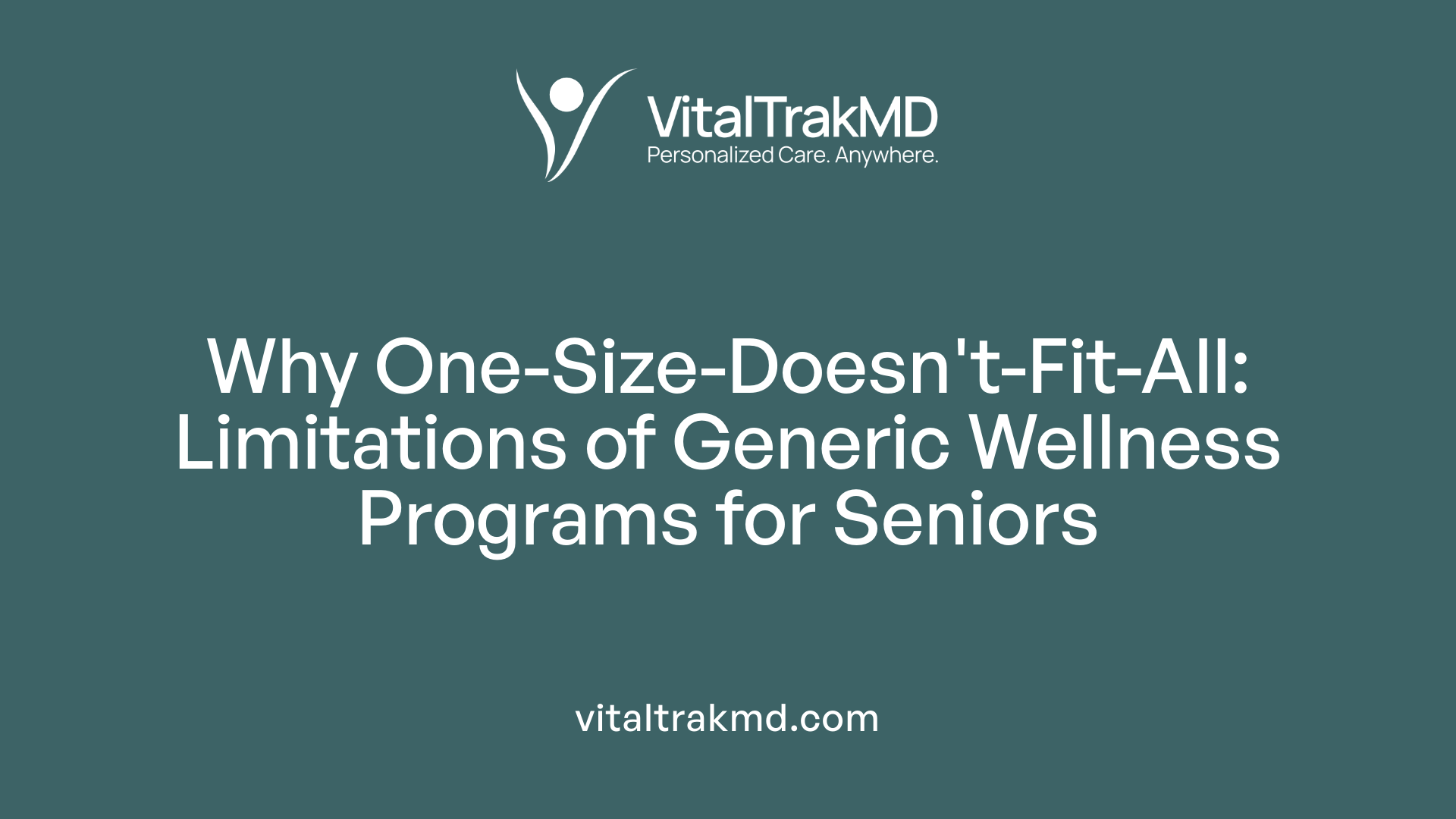The Downsides of One-Size-Fits-All Wellness Programs for Aging Adults

Understanding the Limitations of Uniform Approaches
As the aging population grows, so does the push for wellness programs designed to serve all older adults. However, a one-size-fits-all approach to wellness presents significant challenges and risks, underscoring the need for personalized strategies tailored to individual health conditions, cultural backgrounds, and personal preferences. This article explores the multifaceted downsides of standardized wellness programs for aging adults and highlights the importance of customized care.
The Inadequacy of Uniform Wellness Programs for Older Adults

What are the limitations of one-size-fits-all wellness programs for aging adults?
Generic wellness programs often fall short in meeting the unique needs of older adults. These programs tend to overlook the wide range of physical health conditions, mobility levels, and personal preferences among seniors.
Older adults have diverse interests and capabilities. Some may enjoy social activities like group exercise classes, while others prefer one-on-one coaching or online modules that they can do at their own pace. A broad program that does not offer options or modifications can discourage participation.
Physical limitations are common in older populations. Mobility issues, balance problems, or fears of falling can make standard exercises or activities unsafe or intimidating. Without tailored guidance or adaptive exercises, many seniors may avoid participating altogether.
Many generic programs also lack awareness and accessibility. If they are too complex to join, difficult to understand, or not appropriately scaled to different fitness levels, engagement drops.
To truly benefit older adults, wellness initiatives should be personalized. This involves considering individual health status, motivation, environment, and cultural background. Customized guidance helps ensure safety, increases motivation, and improves overall health outcomes.
In summary, one-size-fits-all wellness approaches are limited because they ignore the heterogeneity among older adults. Personalization not only fosters inclusion but also enhances the effectiveness of health promotion efforts for this demographic.
Disadvantages of Standardized Wellness Approaches for Seniors

What disadvantages do generic or standardized wellness approaches pose for seniors?
Many wellness programs designed without personalization tend to overlook the unique needs and life circumstances of older adults. Seniors are a diverse group, with different health conditions, cultural backgrounds, and personal preferences. When programs adopt a one-size-fits-all approach, they often fail to engage older adults effectively, leading to lower participation rates.
In addition to mismatched content, seniors face specific barriers that can prevent successful engagement. Low digital literacy remains a significant challenge, especially as many interventions involve technology or online platforms. Limited access to digital devices or reliable internet can further restrict their participation.
Physical and cognitive limitations also influence how seniors interact with wellness programs. Conditions such as arthritis, hearing or vision deficits, and cognitive impairments can make standard approaches difficult to follow or utilize confidently.
Dispositional factors like distrust in new interventions, fears of fraud, or resistance to change can also hinder seniors from trying or sticking with standardized wellness solutions. This skepticism may be rooted in previous negative experiences or lack of familiarity.
Overall, these limitations emphasize the need for personalized, accessible, and supportive wellness initiatives. Tailoring interventions to individual health status, technological comfort level, and personal preferences can improve engagement and outcomes for older adults.
Challenges in Addressing the Diverse Needs of Aging Populations

What challenges exist in addressing the diverse needs of aging individuals with uniform wellness programs?
Designing wellness programs for older adults is complex because this population varies greatly in health status, cognitive ability, and mobility. Some seniors may manage well with minimal assistance, while others face multiple chronic conditions or cognitive impairments.
Most older adults have specific, individual health goals and preferences. Many value aging in place and prefer interventions that are personalized to support this choice. Uniform programs often fail to meet these diverse needs, making participation less effective.
Cognitive changes and neurodegenerative diseases like dementia can impact decision-making and motivation to engage in health initiatives. Emotional regulation and personality also influence how seniors respond to different programs.
Social factors, including support networks and socioeconomic status, further complicate the delivery of effective wellness strategies. Limited resources, funding constraints, and lack of awareness about available services can prevent optimal engagement.
Moreover, some seniors might find generic programs confusing or unappealing if they involve complex procedures or incentives that do not resonate with their personal circumstances.
To overcome these challenges, wellness initiatives should be adaptable, promote active participation, and incorporate motivational strategies specific to older adults. This tailored approach increases the likelihood of sustained engagement and improved health outcomes.
In summary, the heterogeneity among older adults necessitates flexible, individualized programs that consider varying health, cognitive, and social needs, rather than a one-size-fits-all model.
Risks and Negative Outcomes of Non-Tailored Wellness Initiatives
Non-personalized wellness initiatives for seniors can carry significant risks. When programs are not adapted to individual health conditions, abilities, and cultural backgrounds, they may inadvertently cause physical harm. For example, activities unsuitable for a senior with mobility limitations or chronic illnesses can lead to injuries or exacerbate existing health problems.
Furthermore, a lack of customization can result in lower participation rates. Older adults may feel that the program is irrelevant or too generic, which can lead to frustration and a sense of alienation. This disconnection discourages engagement, reducing the likelihood that seniors will benefit from health and wellness interventions.
Poorly tailored programs may also lead to misunderstandings or mistrust if communication is inadequate or if they are not supported by trusted healthcare providers and caregivers. Seniors might distrust the intentions behind these initiatives or feel overlooked, thereby decreasing motivation to participate.
Overall, generic wellness strategies risk being ineffective and possibly harmful. They can fail to address specific health risks and personal preferences, which are crucial for successful health outcomes among older adults. Effective programs should consider individual health profiles, cultural contexts, and personal goals to ensure safety, relevance, and engagement, ultimately supporting healthier aging experiences.
The Efficacy of Personalized Wellness Strategies Over Generalized Programs

Are personalized wellness strategies more effective than generic programs for aging populations?
Personalized wellness strategies tend to outperform one-size-fits-all programs, especially among older adults. They are designed to fit individual health conditions, lifestyle preferences, and personal goals, fostering greater engagement and adherence. This tailored approach helps address unique medical needs and social circumstances, leading to better health outcomes.
For example, mobile health technologies that support remote monitoring and chronic disease management enable older adults to stay connected with their healthcare providers, reducing hospital visits and caregiver stress. These tools also promote safety by promptly alerting caregivers or healthcare teams when issues arise.
Holistic senior wellness programs exemplify personalization in practice. Facilities like Baptist Retirement Community and Stonebridge at Montgomery develop individual care plans that encompass physical health, mental well-being, social engagement, and spiritual needs. Such programs support older adults in maintaining independence and emotional health, which are critical aspects of aging well.
Furthermore, personalized strategies can evolve with changing health circumstances, adapting interventions to new challenges and risks. This flexibility aids in avoiding unnecessary hospitalizations, managing chronic illnesses effectively, and preventing functional decline.
Overall, tailoring wellness efforts to the specific needs and preferences of older individuals enhances not only health and safety but also overall satisfaction. Compared to generic programs, personalized approaches foster a sense of control and respect, which are vital for emotional well-being.
In summary:
| Benefit | Example | Impact |
|---|---|---|
| Increased engagement | Customized health apps | Better adherence to health routines |
| Improved health outcomes | Individual care plans | Reduced hospitalization rates |
| Enhanced satisfaction | Personal goal setting | Greater overall well-being |
| Adaptability | Evolving programs | Long-term health maintenance |
Using truly personalized strategies, healthcare providers can significantly improve quality of life for aging populations, proving that individual-focused programs are more effective than generic counterparts.
The Ethical and Fairness Considerations in Wellness Program Design

How do issues of fairness, bias, and ethics affect the implementation of uniform wellness solutions for older adults?
Implementing one-size-fits-all wellness programs for older adults often overlooks individual differences, raising concerns about fairness and equity. Older individuals vary widely in their health risks, cultural backgrounds, personal preferences, and socio-economic status. When programs do not account for this diversity, they can inadvertently reinforce existing disparities or exclude vulnerable groups.
Bias can also creep into design and delivery, favoring certain populations over others based on age, gender, ethnicity, or socioeconomic status. For example, programs that prioritize high-tech solutions might disadvantage older adults with limited digital literacy or access, leading to inequitable outcomes.
From an ethical perspective, respecting the autonomy and dignity of older adults is paramount. Customized approaches that prioritize individual goals and preferences help uphold these principles, ensuring interventions are meaningful and effective.
In addition, fairness and justice demand active inclusion of stakeholders—older adults, caregivers, healthcare providers, and community groups—in the planning process. Such participatory design fosters transparency, legitimacy, and acceptance, reducing the risk of marginalization.
Overall, ethical wellness program development for seniors requires balancing benefits with respect for individual rights, avoiding ageist assumptions, and ensuring equitable access. Tailoring interventions to diverse needs enhances both their effectiveness and fairness, promoting better health outcomes for all older adults.
Fostering Inclusive and Personalized Wellness Strategies
Moving away from standardized wellness programs towards personalized, inclusive approaches is crucial for effectively supporting aging adults. Recognizing their unique health profiles, cultural backgrounds, and personal preferences not only enhances engagement and health outcomes but also promotes fairness and dignity in healthcare delivery. This shift requires policymakers, healthcare providers, and communities to invest in adaptable, stakeholder-driven interventions that respect individual differences. By prioritizing customized strategies, we can ensure wellness programs are equitable, effective, and truly beneficial for every older adult as they navigate the complexities of aging.
References
- One size does not fit all - PMC - National Institutes of Health (NIH) |
- Aging is not one-size-fits-all - WSU's Office of Research
- One Size Doesn't Fit All: A Trial of Individually Tailored Skills Training
- Why Workplace Wellness Programs Aren't One-Size-Fits-All
- How Your Health Priorities Can Help You Get the Care That Matters ...
- The Demise of One-Size-Fits-All Benefit Plans | The Loop
- Barriers and facilitators to the use of e-health by older adults
- Personalized Mobile Health for Elderly Home Care: A Systematic ...
Recent articles
Want to Feel Better and Live Healthier?
Join hundreds of patients taking control of their health with personalized care that fits their life – not the other way around.
Rated 4.8/5 by 32+ customers







